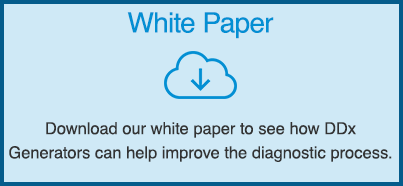- Privacy Policy
- Terms & Conditions
- Contact us
- ©Isabel Healthcare 2025
New resources for clinical reasoning | Diagnostic Error in Medicine
 The Society to Improve Diagnosis in Medicine (SIDM) held its 10th International Diagnostic Error in Medicine Conference in Boston last week, and many companies and organizations, including Isabel Healthcare, came together with the shared goal of improving the medical industry through the diagnostic process. This year’s theme was ‘Improving Diagnosis - It Takes a Team’ and focused on diagnostic reliability and how important the collaboration of the whole multi-disciplinary team is within this process. The conference featured renowned speakers from the diagnostic error and patient safety fields, as well as interactive workshops and breakout sessions enhancing the multidisciplinary team focus.
The Society to Improve Diagnosis in Medicine (SIDM) held its 10th International Diagnostic Error in Medicine Conference in Boston last week, and many companies and organizations, including Isabel Healthcare, came together with the shared goal of improving the medical industry through the diagnostic process. This year’s theme was ‘Improving Diagnosis - It Takes a Team’ and focused on diagnostic reliability and how important the collaboration of the whole multi-disciplinary team is within this process. The conference featured renowned speakers from the diagnostic error and patient safety fields, as well as interactive workshops and breakout sessions enhancing the multidisciplinary team focus.
During the conference SIDM announced two new resources to help physicians improve their knowledge and competencies around their diagnostic skills. These tools are called “Assessment of Reasoning Tool (ART)” and “Getting It Right: Cases to Improve Diagnosis.” We applaud the launch of both of these tools and have outlined them in this blogpost.
Assessment of Reasoning Tool (ART)
SIDM notes on its website that errors in clinical reasoning are central factors in many diagnostic errors, and they have developed a straightforward tool to support educators in assessing a learner’s clinical reasoning skills during patient presentations. ART is a simple yet efficient resource which facilitates feedback discussions between educator and learner at five different points in the diagnostic process. Using the feedback, learners can see where their own skills are on point, or where they could improve their feedback and skills to ensure they have considered all factors within the clinical evaluation to build an accurate differential diagnosis.
More information can be found here on SIDM ART which includes five development videos that focus on understanding the diagnostic process, and how the ART tool can be implemented at each stage. The areas within the diagnostic process include:
- Hypothesis-Directed Collection - collecting history and ensuring examination is focused on important and leading diagnoses, that it follows a logical path, and that the working differential is modified as the data gathered supports or refutes potential diagnoses
- Problem Representation – ensuring it is a complete concise synthesis of the clinical problem which needs to be solved
- Prioritized Differential Diagnosis – probability ranking of diseases the patient could have based on their history, generating the leading hypothesis, can’t miss diagnoses, and considering less likely and unlikely diagnoses weighted by evidence to support the physician’s thinking. Via this method a concise differential diagnosis will be considered based on the patient’s data collection
- High Value Testing – ensuring testing is appropriate based on the prioritized differential diagnosis and testing for the most likely and can’t miss diagnoses, and sometimes the less likely diagnoses, to rule diseases in and out of your differential diagnosis
- Metacognition – Analyzing diagnostic cognitive processes and ensuring the learner is not anchoring or using their own biases which affect their medical decisions.
These videos and the ART resource as a whole was produced by SIDM with a grant from the American Board of Medicine. It successfully lays out a clear five-point pathway which learners can use to analyze their thinking and actions, to ensure they have taken everything into consideration when working through a patient’s problem workflow. The third stage of prioritizing a differential diagnosis is where computerised decision support systems, such as the Isabel DDx Generator, can be used to support the learner. Tools such as this allow them to refine their thought processes with evidenced based research and ensure the testing in the fourth stage is appropriate.
Getting It Right: Cases to Improve Diagnosis
SIDM collaborated with the American College of Physicians (ACP) to produce the module, a set of learning cases which allow physicians to examine their diagnostic decision-making and how diagnostic errors can be mitigated. Topics covered in the Getting It Right module include:
- Understanding the Diagnostic Process
- Analyzing Cognitive and Systemic Contributions to Diagnostic Errors
- Partnering with Patients and Families in the Diagnostic Decision-Making Process
- Physician and Patient Factors in Diagnostic Decision-Making
- Recognizing and Responding to Diagnostic Errors
This is another great resource to have come out of this year’s SIDM International Conference. These interactive cases are packed full of information, and are available for free on ACP’s website. Physicians can earn CME credit and ABIM Maintenance of Certification points by completing the modules.
With the SIDM 10th Conference now finished it is great to see how far things have come in the past ten years with regards to tackling diagnosis error and improving diagnosis in health care. It is fantastic to see a focus on developing new tools which will work symbiotically with both physician and the Isabel DDx Generator to ensure the patient receives a highly accurate and timely diagnosis. Diagnosis today, as highlighted in the conference, has teamwork and collaboration at the heart of the matter, and this was never more evident than at this year’s conference for Improving Diagnosis. These new resources will be invaluable to all those involved in the team and responsible for patient care from learners, educators, physicians and the whole multi-disciplinary team. There are always new things we can learn in to reduce diagnostic error and improve our clinical reasoning skills and understanding.
“The life so short, the craft so long to learn”
Hippocrates
Have you read our white paper on Why and How to Improve Diagnosis? It's got a lot more information on why we think improving diagnosis is so important, and how differential diagnosis generators like Isabel can help.
Subconscious Thought Process Vector | designed by Qvectors

Mandy Tomlinson
Mandy has worked for Isabel Healthcare since 2000. Prior to this, she was a Senior Staff Nurse on the Pediatric Infectious disease ward and high dependency unit at one of London's top hospitals, St Mary’s in Paddington which is part of Imperial College Healthcare NHS Trust. Her experience in the healthcare industry for the past 33 years in both the UK and USA means she's a vital resource for our organization. Mandy currently lives and works in Scottsdale, Arizona.
Subscribe Here!
Recent Posts
Isabel DDx Companion with ChatGPT Integration - to help you diagnose even faster
At Isabel Healthcare, we’ve always been driven by one goal: to make clinical reasoning faster,..Virtual Triage: Do more questions lead to better patient outcomes?
One of the common misconceptions related to virtual triage / symptom checker tools is that the more..List Of Categories
- Differential Diagnosis Decision Support
- Differential diagnosis
- Symptom Checker
- Symptoms
- Medical Error
- Patient Disease Information
- Disease
- Clinical Decision Support
- Diagnostic Decision Support
- Isabel 1 Minute Read
- Diagnosis Error
- Diagnosis Skills Cases
- Healthcare Informatics
- Clinical Reasoning
- Evidence-based Medicine
- Medical Education
- Patient Engagement
- Symptom Triage
- Nurse Practitioner Education
- Nursing Decision Support
- Partnership
- Public Health
- COVID-19
- EHR
- Patient Empowerment
- Patient Safety
- rare disease

Start your FREE Trial today
Try the Isabel Pro DDx generator for 30-days - no payment card details required.




